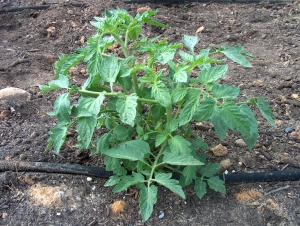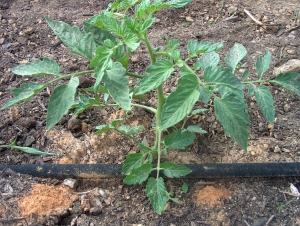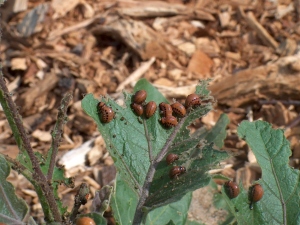by Janine Butler, garden volunteer
In last week’s blog, I commented on how well all the plants had been growing over the last couple of weeks. Well guess what else has been growing? Yep, WEEDS! I spent a good hour or so on Saturday using a cool tool called a scuffle hoe – you move it back and forth as if you were sweeping the floor, except instead of collecting dirt it wacks the top of the weeds off! It works pretty well for the broadleaf weeds, but we also have some pesky wiry, grassy weed, which is a bit harder to get rid of. We might have to find something else for those guys.
Also this week, we continued to put down lots and lots of mulch. I am hoping that if we lay it down thick enough then we can squash the weeds! I have to admit I am getting pretty good at mulching; it must be all the practice I am getting! And something else I learned this week – mulch needs nitrogen to break it down, and tomatoes need nitrogen to grow. Some of the mulch we have is a little ‘green’ and new, so we had to make sure that it doesn’t get too close to the plants, especially tomatoes. You don’t really want the plants to work so hard to get the nitrogen from the soil so you should make sure that the mulch is about 12 inches from the plants. In an ideal world you would have older mulch, but we need so much mulch that we have to take what we can get.
Tom Brinda, Assistant Executive Director, at Lewis Ginter updated me on some of the other things that they have been doing. Basil seeds had been planted, and they were starting to sprout. Soon we will have to thin them out a bit to make room and help them grow bigger. The staff have also been feeding all the plants, because just like you and me they also need good food to help them grow! Apparently you should feed every couple of weeks; we will do that in two ways 1) by using liquid food to “water” the plants, and 2) by side-feeding, where the plant food is sprinkled on the ground a few inches away from the plants to encourage good root growth.
We also had some mystery guests this week and they seem pretty fond of the eggplants and peppers. We are still working to find out what these insects are. These bugs are quite round in shape, and a brownish color. I will try to take a photo of them the next time I am out there – if anyone has any ideas what they could be then let us know! We had a new volunteer this week, a teenager and Tom put him on bug removal duty. I will stick to mulching thank you very much!
After bug duty the teenage finished planting zucchini seeds. I was really impressed by his enthusiasm — it’s great to see teenagers taking an interest in planting and growing stuff.
I have also been impressed lately by tales from my friends and neighbors who are growing their own veggies. My neighbor Susan has already got a spicy green chili pepper (just one, but more should be on the way) and a couple of peas. My friend’s husband Dan has a fantastic garden going on in his backyard – I am trying to rope him into volunteering here!
I hope that you too are all having success in your own gardens! And if you’d like to join the fun, remember we are here working on the Community Kitchen Garden at Lewis Ginter every Monday and Saturday from 9 am to noon, so stop by and give us some help, if you have a green thumb.
Read Full Post »












